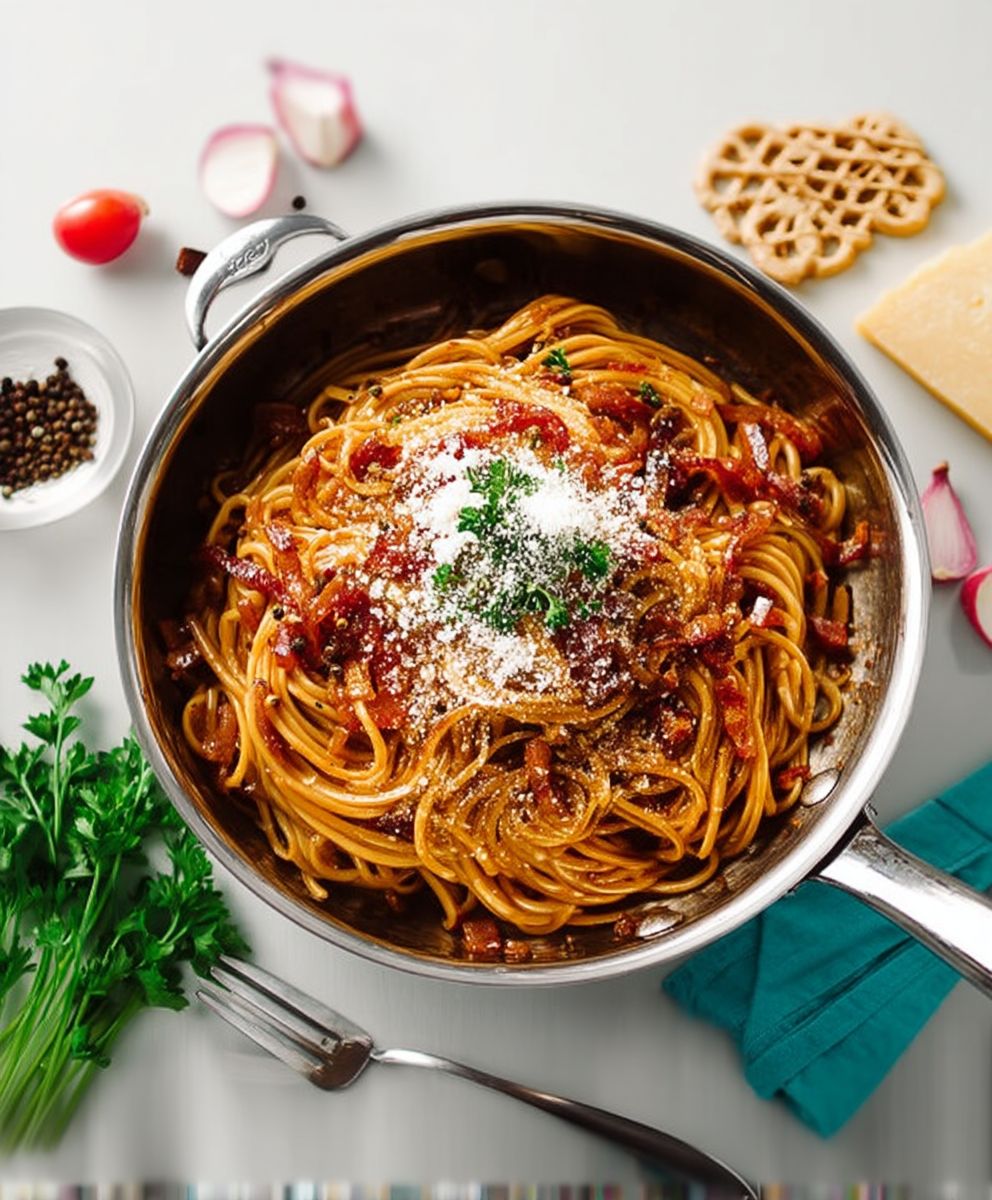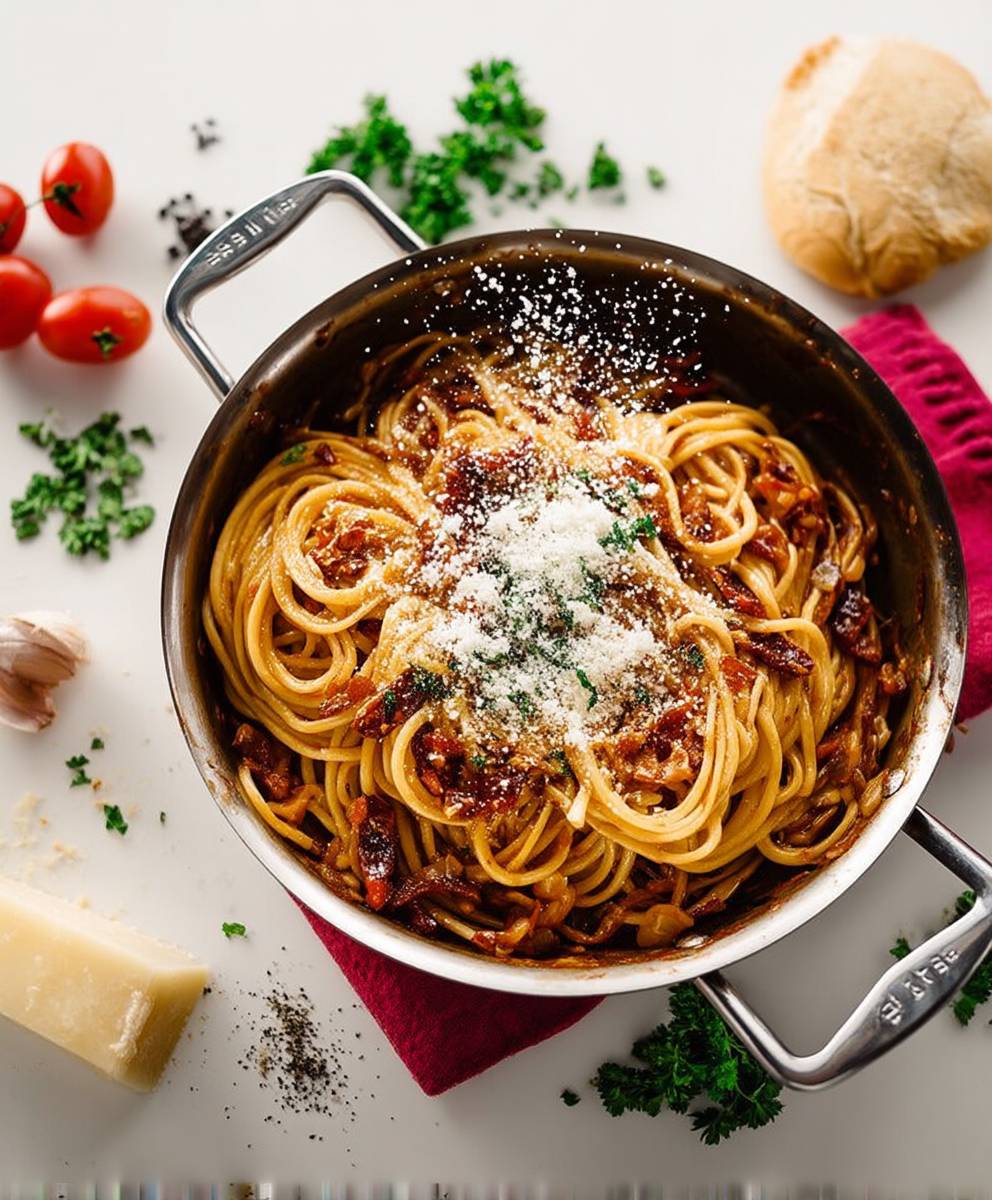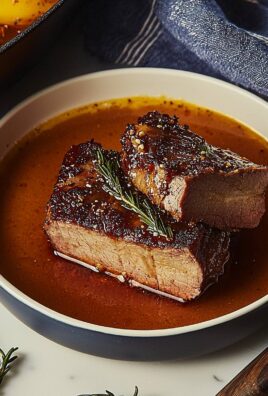Pasta all’Amatriciana: just the name conjures up images of sun-drenched Roman trattorias and the tantalizing aroma of guanciale sizzling in a pan. Have you ever experienced that perfect bite, where the rich, savory sauce clings lovingly to perfectly cooked pasta, delivering an explosion of flavor that leaves you craving more? Well, get ready, because I’m about to share my foolproof recipe for this iconic Italian dish!
This isn’t just any pasta dish; it’s a culinary journey steeped in history. Originating from the town of Amatrice in the Lazio region of Italy, Pasta all’Amatriciana began as a humble shepherd’s meal, relying on simple, readily available ingredients like guanciale (cured pork cheek), pecorino romano cheese, and tomatoes. Over time, it evolved into a beloved staple of Roman cuisine, celebrated for its robust flavors and satisfying simplicity.
What makes Amatriciana so irresistible? It’s the harmonious blend of textures and tastes. The crispy, rendered guanciale provides a salty, savory depth, while the tangy tomatoes add a touch of sweetness and acidity. The pecorino romano, with its sharp, salty bite, perfectly complements the other ingredients, creating a symphony of flavors that dance on your palate. Plus, it’s surprisingly quick and easy to prepare, making it a perfect weeknight meal that’s sure to impress. So, let’s dive in and create some magic in the kitchen!
Ingredients:
- 1 pound guanciale, cut into 1/4-inch thick lardons
- 1 tablespoon olive oil (optional, depending on the fat content of your guanciale)
- 1/2 teaspoon red pepper flakes, or more to taste
- 1/2 cup dry white wine
- 1 (28 ounce) can whole peeled tomatoes, crushed by hand or with a potato masher
- Salt to taste (be mindful of the saltiness of the guanciale)
- Freshly ground black pepper to taste
- 1 pound bucatini pasta (or spaghetti, if you prefer)
- Pecorino Romano cheese, freshly grated, for serving
Preparing the Guanciale:
Okay, let’s start with the star of the show: the guanciale! This cured pork cheek is what gives Amatriciana its unique flavor. Don’t substitute with pancetta or bacon if you can help it; guanciale has a richer, more complex flavor that’s essential to the dish.
- Cut the guanciale: First, you’ll want to cut the guanciale into lardons, which are basically small, thick batons. Aim for about 1/4-inch thick and 1/2-inch wide. This size will render nicely and create crispy bits of deliciousness.
- Render the fat: Place the guanciale in a large skillet or Dutch oven over medium heat. You don’t need to add any oil at this point, as the guanciale will release its own fat. Cook, stirring occasionally, until the guanciale is crispy and golden brown. This usually takes about 8-10 minutes. Be patient and don’t overcrowd the pan; if necessary, cook the guanciale in batches.
- Remove the guanciale: Once the guanciale is crispy, remove it from the pan with a slotted spoon and set it aside on a plate lined with paper towels to drain. Reserve the rendered fat in the pan this is liquid gold!
- Adjust the fat (optional): If your guanciale didn’t render a lot of fat (sometimes it happens!), you can add a tablespoon of olive oil to the pan. You want enough fat to coat the bottom of the pan nicely.
Making the Sauce:
Now for the sauce! This is where the magic happens. Keep it simple, keep it fresh, and let the ingredients shine.
- Add the red pepper flakes: Add the red pepper flakes to the rendered guanciale fat in the pan. Cook for about 30 seconds, stirring constantly, until fragrant. Be careful not to burn them! The heat from the fat will release their flavor and add a nice kick to the sauce.
- Deglaze with white wine: Pour in the dry white wine and scrape up any browned bits from the bottom of the pan. This is called deglazing, and it adds a ton of flavor to the sauce. Let the wine simmer for a minute or two, until it’s almost completely evaporated.
- Add the tomatoes: Add the crushed tomatoes to the pan. I prefer to use whole peeled tomatoes and crush them by hand or with a potato masher, as this gives the sauce a chunkier, more rustic texture. You can also use canned crushed tomatoes if you prefer.
- Season and simmer: Season the sauce with salt and freshly ground black pepper to taste. Remember that the guanciale is already salty, so start with a small amount of salt and add more as needed. Bring the sauce to a simmer, then reduce the heat to low and cook for at least 15-20 minutes, or up to an hour, stirring occasionally. The longer it simmers, the more the flavors will meld together.
- Adjust consistency (if needed): If the sauce becomes too thick, you can add a little bit of pasta water to thin it out.
Cooking the Pasta:
While the sauce is simmering, it’s time to cook the pasta. Bucatini is the traditional pasta for Amatriciana, but spaghetti works just as well. The key is to cook the pasta al dente, which means “to the tooth” in Italian. It should be firm and slightly chewy.
- Bring water to a boil: Bring a large pot of salted water to a rolling boil. Use plenty of water at least 6 quarts for a pound of pasta. The salt is important for seasoning the pasta from the inside out.
- Cook the pasta: Add the bucatini to the boiling water and cook according to the package directions, until al dente. Start checking for doneness a minute or two before the recommended cooking time.
- Reserve pasta water: Before draining the pasta, reserve about 1 cup of the pasta water. This starchy water is a secret weapon for creating a creamy, emulsified sauce.
- Drain the pasta: Drain the pasta in a colander. Don’t rinse it! Rinsing removes the starch that helps the sauce cling to the pasta.
Bringing it All Together:
Now for the best part: combining the pasta and sauce! This is where everything comes together to create a truly unforgettable dish.
- Add pasta to the sauce: Add the drained pasta to the skillet with the Amatriciana sauce. Toss well to coat the pasta evenly with the sauce.
- Add guanciale: Add most of the crispy guanciale back to the pan, reserving a little for garnish. Toss again to combine.
- Add pasta water (if needed): If the sauce seems too thick, add a little bit of the reserved pasta water, one tablespoon at a time, until it reaches your desired consistency. The pasta water will help to emulsify the sauce and create a creamy texture.
- Grate in Pecorino Romano: Grate a generous amount of Pecorino Romano cheese directly into the pan. Toss well to combine. The cheese will melt into the sauce and add a salty, savory flavor.
- Serve immediately: Serve the Amatriciana immediately, garnished with the remaining crispy guanciale and more freshly grated Pecorino Romano cheese. A sprinkle of freshly ground black pepper is also a nice touch.
Tips for Success:
- Use high-quality ingredients: The quality of your ingredients will make a big difference in the final result. Use the best guanciale, tomatoes, and Pecorino Romano cheese you can find.
- Don’t overcook the pasta: Overcooked pasta is mushy and unpleasant. Cook it al dente for the best texture.
- Don’t be afraid to experiment: This recipe is a guideline, not a rigid set of rules. Feel free to adjust the ingredients and seasonings to your liking. For example, some people like to add a pinch of sugar to the sauce to balance the acidity of the tomatoes.
- Serve with a glass of red wine: Amatriciana pairs perfectly with a dry red wine, such as a Chianti or Montepulciano.
Enjoy!
That’s it! You’ve just made a delicious and authentic Pasta all’Amatriciana. Enjoy this classic Roman dish with your family and friends. Buon appetito!

Conclusion:
This isn’t just another pasta recipe; it’s an invitation to experience a taste of Roman history, a culinary journey that’s both deeply satisfying and surprisingly simple. The rich, savory sauce, clinging perfectly to each strand of pasta, is a testament to the power of simple, high-quality ingredients. From the crispy guanciale to the tangy tomatoes and the sharp Pecorino Romano, every element plays a crucial role in creating a symphony of flavors that will leave you craving more. I truly believe that this Pasta all’Amatriciana is a must-try for any pasta lover, and I’m confident that it will become a regular in your rotation.
But the beauty of cooking lies in its adaptability, and this recipe is no exception. While I’ve shared my tried-and-true method, feel free to experiment and make it your own. For a spicier kick, add a pinch of red pepper flakes to the sauce. If you’re feeling adventurous, try using different types of pasta rigatoni or bucatini would work wonderfully. And for a vegetarian twist, you could substitute the guanciale with smoked paprika and a touch of liquid smoke to mimic that savory, smoky flavor.
Serving Suggestions and Variations:
* Classic Presentation: Serve your Pasta all’Amatriciana immediately after cooking, garnished with a generous grating of Pecorino Romano cheese and a drizzle of extra virgin olive oil.
* Wine Pairing: Pair this dish with a medium-bodied red wine, such as a Chianti Classico or a Montepulciano d’Abruzzo, to complement the rich flavors of the sauce.
* Side Dish: A simple green salad with a light vinaigrette is the perfect accompaniment to balance the richness of the pasta.
* Spice It Up: As mentioned earlier, a pinch of red pepper flakes can add a delightful kick to the sauce. Start with a small amount and adjust to your preference.
* Vegetarian Option: While traditionally made with guanciale, you can create a vegetarian version by using smoked paprika and a touch of liquid smoke to mimic the smoky flavor. You can also add some roasted vegetables like eggplant or zucchini for added texture and flavor.
* Pasta Variations: While spaghetti is the classic choice, feel free to experiment with other pasta shapes like rigatoni, bucatini, or penne. Each shape will offer a slightly different texture and sauce-to-pasta ratio.
I’ve poured my heart into perfecting this recipe, and I’m so excited for you to try it. Don’t be intimidated by the seemingly simple ingredient list; the magic lies in the technique and the quality of the ingredients. Seek out authentic guanciale and Pecorino Romano for the best results. Take your time, savor the process, and most importantly, have fun!
I truly believe that this Pasta all’Amatriciana will transport you to the heart of Rome with every bite. It’s a dish that’s perfect for a weeknight dinner or a special occasion, and it’s sure to impress your family and friends.
Now, it’s your turn! I encourage you to give this recipe a try and experience the deliciousness for yourself. And please, don’t be shy share your creations with me! I’d love to see your photos, hear about your variations, and learn about your experiences. Tag me in your posts on social media, or leave a comment below. I can’t wait to hear what you think! Happy cooking!
Pasta all'Amatriciana: The Authentic Recipe and Guide
Authentic Pasta all'Amatriciana, a classic Roman dish with crispy guanciale, rich tomato sauce, and Pecorino Romano cheese.
Ingredients
- 1 pound guanciale, cut into 1/4-inch thick lardons
- 1 tablespoon olive oil (optional, depending on the fat content of your guanciale)
- 1/2 teaspoon red pepper flakes, or more to taste
- 1/2 cup dry white wine
- 1 (28 ounce) can whole peeled tomatoes, crushed by hand or with a potato masher
- Salt to taste (be mindful of the saltiness of the guanciale)
- Freshly ground black pepper to taste
- 1 pound bucatini pasta (or spaghetti, if you prefer)
- Pecorino Romano cheese, freshly grated, for serving
Instructions
- Prepare the Guanciale: Cut the guanciale into 1/4-inch thick lardons. Place in a large skillet or Dutch oven over medium heat. Cook, stirring occasionally, until crispy and golden brown (8-10 minutes). Remove with a slotted spoon and set aside on a plate lined with paper towels. Reserve the rendered fat in the pan. If needed, add 1 tablespoon of olive oil to the pan.
- Make the Sauce: Add the red pepper flakes to the rendered guanciale fat in the pan. Cook for 30 seconds, stirring constantly, until fragrant. Pour in the dry white wine and scrape up any browned bits from the bottom of the pan. Simmer for 1-2 minutes, until almost completely evaporated. Add the crushed tomatoes, salt, and pepper. Bring to a simmer, then reduce heat to low and cook for 15-20 minutes (or up to an hour), stirring occasionally. If the sauce becomes too thick, add a little pasta water to thin it out.
- Cook the Pasta: Bring a large pot of salted water to a rolling boil. Add the bucatini and cook according to package directions, until al dente. Reserve 1 cup of pasta water before draining. Drain the pasta in a colander (do not rinse).
- Combine: Add the drained pasta to the skillet with the Amatriciana sauce. Toss well to coat. Add most of the crispy guanciale back to the pan, reserving some for garnish. Toss again. If the sauce seems too thick, add pasta water, one tablespoon at a time, until desired consistency is reached. Grate a generous amount of Pecorino Romano cheese directly into the pan. Toss well to combine.
- Serve: Serve immediately, garnished with the remaining crispy guanciale and more freshly grated Pecorino Romano cheese. Sprinkle with freshly ground black pepper.
Notes
- Use high-quality ingredients for the best flavor.
- Don’t overcook the pasta; cook it al dente.
- Adjust the amount of red pepper flakes to your spice preference.
- If you can’t find guanciale, pancetta can be used as a substitute, but the flavor will be slightly different.
- Serve with a dry red wine like Chianti or Montepulciano.





Leave a Comment